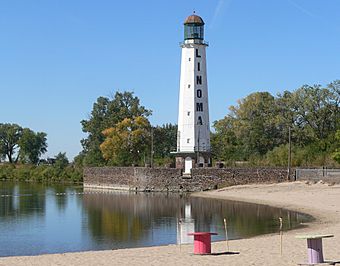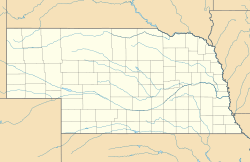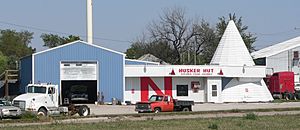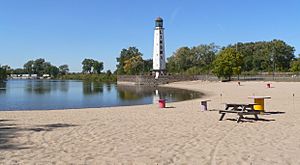Linoma Beach facts for kids
Quick facts for kids |
|
|
Linoma Beach
|
|

Linoma Beach and lighthouse
|
|
| Nearest city | Ashland, Nebraska |
|---|---|
| Area | 59 acres (24 ha) |
| Built | 1924 |
| NRHP reference No. | 03000107 |
| Added to NRHP | March 11, 2003 |
Linoma Beach, also known as Linoma Lighthouse, is a fun place to visit in Sarpy County, Nebraska. It's a private recreation area built around a man-made lake. The resort first opened its doors in 1924. Later, in 1939, a 100-foot (30 m) lighthouse was built there. This lighthouse is a famous sight along U.S. Highway 6 between the cities of Omaha and Lincoln, Nebraska.
Linoma Beach is important because it's listed on the National Register of Historic Places. It's a great example of old roadside attractions that are now rare.
Contents
How Linoma Beach Began
Creating a Fun Spot
Back in 1907, a company called Lyman-Richey Sand Company started digging for sand and gravel. They worked near the Platte River, close to Ashland, Nebraska. They kept digging until 1915. All this digging created several small lakes fed by underground springs.
Around 1920, two businessmen, Harry E. Schellberg and Lawrence G. Simpson, formed a group. By 1924, they bought some of the land with these lakes. In 1924, their group became the Linoma Realty Company. That same year, they opened the Linoma Beach resort at the old digging site.
The resort was located about halfway between Nebraska's two biggest cities, Lincoln and Omaha. It was about 30 miles (50 km) from each city. The name "Linoma" is a mix of the first few letters of "Lincoln" and "Omaha."
The company worked hard to make the site ready. The sandpit lakes were very deep, about 50 to 60 feet (15 to 18 m), which made them unsafe for swimming. To fix this, they pumped in a lot of sand. They also moved sand to create a wide beach, over 100 feet (30 m) wide and 600 feet (180 m) long. They built a nice, clean bathhouse with mirrors and electric lights. There were also large picnic areas. An old farmhouse was turned into a restaurant with a porch perfect for dancing. The first manager of the restaurant was Alfred Jones, a well-known cook from Omaha. It was unusual for a non-white person to have such a big job back then.
Getting There: Roads and Rails
People could get to the new resort by car or by train. To get the Chicago, Burlington and Quincy Railroad to stop at Linoma, the developers built a platform and added lights. On Saturdays and Sundays, three trains would stop there. A round-trip ticket from Omaha cost $1.11, and from Lincoln, it was $1.10.
Drivers could also reach Linoma. In 1911, a group was formed to improve roads in Nebraska. They planned the Omaha-Lincoln-Denver (O‑L‑D) Highway. In 1920, this highway became part of the larger Detroit-Lincoln-Denver (D‑L‑D) Highway. A law in 1921 provided money for highway improvements. This helped Nebraska put gravel on the D‑L‑D Highway. By 1927, ads for Linoma Beach proudly said the road was fully graveled, so cars could drive on it in all kinds of weather.
Grand Opening and Fun Times
Linoma Beach had its grand opening on July 4, 1924. Many people visited that first year. For example, the resort collected $1,236 from beach admissions, which cost 25 cents per person. The resort was popular day and night, and the evening dances were a big hit.
Lawrence G. Simpson, who took over the business in 1925, built a dance pavilion. He started charging five cents for dancing. Local bands played on Wednesday, Saturday, and Sunday nights. Not everyone was happy about the Sunday night dances. Ministers from Ashland complained that fewer people were coming to church. They learned that Nebraska had a strict law against public dancing on Sundays. However, Simpson found a clever way around it. The law said public dances were illegal, but private dance clubs could rent the pavilion. So, he started the "Ben Ahamo" dance club, and people could buy memberships to dance on Sunday nights.
The resort, including the evening dances, stayed popular. For the 1927 season, they added 75 new picnic tables and planted 300 maple trees. To control weeds, the manager brought in 100 sheep! For the 1928 season, the whole recreation area was fenced. This allowed the manager to charge a ten-cent admission fee on Sundays, though it was still free on other days.
Even when the Great Depression started, Linoma remained popular. On July 4, 1930, 1,700 people visited. However, dancing became less popular. By 1930, dances were only held one night a week. In 1931, the railroad line and the highway (now U.S. Highway 38) were moved because of floods. This meant the dance pavilion had to be torn down, and it was not rebuilt.
The Age of Cars and the Lighthouse
As more people owned cars and roads got better, more visitors came to Linoma by car. In 1933, Simpson paved a parking lot and surrounded it with a stone wall. To handle more visitors, 100 new tables were added, so up to 5,000 people could sit.
To attract drivers, businesses along Nebraska's roads built fun and eye-catching buildings. Some places built teepee-shaped buildings, like a motel in Hastings and a gift shop in Atlanta. Near Hastings, there was even a building shaped like a Mississippi River side-wheeler boat, complete with a fake paddle wheel.
Since Linoma was a lakeside attraction, it chose a water theme. In 1939, a 100-foot (30 m) lighthouse was built next to the highway. The bottom of the lighthouse was a gas station. A spiral staircase inside led to observation decks on the second and tenth floors. The tenth-floor deck went around the lighthouse's light. The rooms above the first floor had plumbing, stoves, and windows. It's thought they might have been for people to stay overnight.
During World War II, gasoline was limited, which stopped car tourism. When the war ended, the lighthouse's beacon flashed the Morse code "V" for "victory." However, Linoma's popularity declined. The lighthouse fell into disrepair, and the restaurant closed.
Saving and Renewing Linoma Beach
In 2003, Linoma Beach was added to the National Register of Historic Places. The lighthouse was especially important because it showed a type of roadside architecture that was disappearing from the early 1900s.
In 2010, a group of five local investors bought the property. They paid $905,000 for it. The group planned to keep the campground open and find someone to run the restaurant. They also wanted to hold special events at the resort. They hoped to give the lighthouse to a special group that would restore and protect it.
In 2011, Linoma Beach was open seven days a week during its season. The campground was still open, and the swimming beach was reopened. A beach-themed bar and grill, the Linoma Beach Bar, was also set up. Even though bad weather canceled the first special event, many people visited. This was partly because floods in 2011 closed other resorts, sending their visitors to Linoma.





